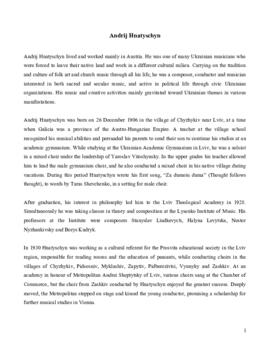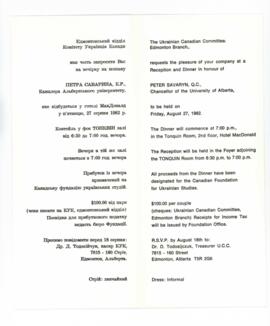Andriy Nahachewsky is talking to Sister Servant during the festive lunch after F. Malinowsky ordination ceremony. (Sisters Servants clothing)
The collection consists of various course assignments submitted by Andriy when he was a master and PhD student in the Ukrainian Folklore Program at the University of Alberta. The assignments cover different topics of Ukrainian and Ukrainian Canadian traditional culture and folklore, and include field recordings as well as final essays.
Nahachewsky, AndriyThis collection contains the results of two ethnographic trips to the Ukrainian communities in Brazil by Andriy Nahachewsky. The first trip took place from 4 May to 26 May 2009, and included Andriy Nahachewsky, Serge Cipko, John C. Lehr, and Maryna Hrymych. This was the first trip to Brazil for each of the participants, though they each had strong credentials in their disciplines and in fieldwork more generally. Thus the project goal was to cast a wide net for general orientation into the historical and contemporary life of the Ukrainian communities there. Each researcher also had specific personal goals. The trip included visits to Curitiba, Prudentópolis and several rural communities nearby, Craveiro in Santa Catarina, São Paulo, Brasília, and Foz do Iguaçu. The agenda included visits to an agricultural cooperative, meetings with diplomats and organizational representatives, and diverse individuals who could speak about life in their communities. Photographs by Hrymych, Lehr, and Cipko are also accessioned into the BMUFA and located in their own respective collections.
The second trip was undertaken by Andriy Nahachewsky, for 6 months from 14 November 2009 to 13 May 2010. The goal of the project was to continue the first exploratory fieldtrip, intensifying and expanding it. The project had a strong diachronic focus, documenting change in cultural traditions, to understand better how Ukrainian cultural content, rooted in 19th century rural traditions in western Ukraine, became transplanted, disappeared, adapted, and sometimes newly created in its diaspora setting in the Brazilian context. The intent was to be able to compare these processes with similar ones known from the Ukrainian Canadian context, as well as culture in western Ukraine itself, which also changed significantly over the 20th century: One cultural root, and three branches evolving on three continents over 120 years.
Another aspect of the fieldtrip was connected with Nahachewsky’s earlier “Local Culture and Diversity on the Prairies” project, which strove to provide documentation about regional differences in traditional Ukrainian culture in the Canadian setting. This аspect of the project was to try trace local differences in Brazilian culture in a similar way. Some of these regional differences were probably most clear in past decades. A third aspect was more synchronic, aimed to document contemporary life. Connected with this, the Brazil trip involved travelling to some 65 communities in the states of Paraná, Santa Catarina, Rio de Janeiro, and São Paulo, the main Ukrainian settlement areas in Brazil. The project involved recording some 300 audio interviews, 53 hours of video recordings of contemporary events, 14,000 photographs, and gathering many publications and manuscripts (in hard copy and reproduced digitally), as well as diverse artifacts. The overall focus in subject matter was broad, including material culture (farming practices, folk arts), customs (calendar holidays, weddings, funerals, etc) and performing arts (music, dance). Special foci developed for dance materials, religious images, church architecture, cemeteries, music, and weddings, because of Nahachewsky’s research background, opportunities, and experiences as the fieldwork proceeded. The trips were both funded by the Huculak Chair and the Kule Folklore Centre (for the first trip: Nahachewsky, Hrymych, and various shared expenses). During both trips, the hosts in the home base in Prudentópolis, as well as other locations in Brazil, were very warm and hospitable, open, and generous. A copy of the digital photo, audio, and video fieldwork materials was deposited in the Museu do Milênio in Prudentópolis.
Nahachewsky, AndriyAndriy Nahachewsky is talking to the Basilian brother inside the Sagrada familia Iracema Church, Santa Catarina. One can notice ritual gesture of Basilian brother, (fragment of church interior)
Andriy Nahachewsky is talking to the Basilian brother inside the Sagrada familia Iracema Church, Santa Catarina. (Fragment of church interior)
Through observation and interviews with participants and organizers of a specific festival, describes the cultural revival of St. Andrew's Day Festival at St. Andrew's Ukrainian Orthodox Parish of Edmonton
Hohol, KeenanFile contains one biography on Andrij Hnatyschyn written by Taras Filenko and translated by Lada Hornjatkevyc.
Born August 20, 1926 in Kingston. His father came to Canada in 1912 from Kamianets-Podil’s’k, worked in tannery, went back to Ukraine in 1914, married his mother and left her there. She came only in 1925. His father never joined any organizations. The first group of Ukrainians in Kingston worked for the Tan Hightes Company (???). Learned English only when went to school. Small community of Ukrainians in Kingston when Andriesky was growing up but no basic organizations. Had yearly parties like Malanka. Still there was a Ukrainian school in a private house where children learned the language. No Ukrainian church back then, only Roman-Catholic cathedral (in the late 1930s there were 2 of them already). Priest Boreky (???) who later became a bishop. Felt foreigners because of the last name. Most of the Ukrainians were in the city. Had a Jason Farm next to them, there was Braznyky (???) family. Kotovych and Vudiks (???) came in the 1930s, but not much of an immigration to the Kingston area between the wars. Then Nyc Gulka came into town and split the community up, and they started to build a Hall (UNF). Fascists vs Commies camps. Andriesky’s father subscribed to a Ukrainian newspaper. During WWII Andriesky made corvettes. In about 1946-48 the community really polarized: either Fascists or Communists. DPs developed a new Hall. John Sapletynsky (???) was the last treasure of the original Hall (Labor Temple). Andriesky’s organization operated under a warrant of the Ontario Company’s Act. Fred Katovich (???)
Kingston had between 25000-30000 population between the wars, not it is a diverse community. Andriesky is an electronic technician repairing appliances now. Wife - Wilda Helen Andriesky (nee Harker), her mother was German and father was a methodist minister. have no children. Three dancing Ukrainian groups in the community: Maky, Sadochok, The Doors - all run by the Ukrainian-Canadian Club of Kingston that was formed 3 years ago. Andriesky helped to write its Constitution. Liubomyr Lutsiuk was the originator. Tarnowecky (???) married the John Wytyk’s daughter, and started a professional dance group, which now stations in Toronto.
Part 1: Born in 1922, in Halychyna; emigrated from Ukraine to Canada in 1930, to Sudbury, ON; discrimination against ethnic minorities in Canada; ethnic gangs; Ukrainian National Federation (UNF) in Ontario; Molodi Ukrains’ki Natsionalisty (MUN) in Sudbury and Toronto; Ukrainian cultural participation in Canada; WWII; Ukrainian communist groups in Sudbury and Toronto; Canadian political parties in the 1930s; Pidzamecky; Stas; Shaneks; Philipchuk; Paul Yuzyk; Pawliuk; Kosar; language use: English and Ukrainian; Konovalets’ assassination in 1938 (Ukrainian movement leader in Ukraine); flying school and parachute jumping courses through MUN; Svarich; attended OCAD; convention at Massey Hall, late 1930s; WWII army service overseas (England, France, Philippines, North Africa); displaced persons in Germany; Amelia Richards (wife); Ukrainian Servicemen’s club in England; Ukrainian guerrilla army; Bandera/Ukrainian nationalists’ split post-WWII; St. Mary’s Ukrainian Catholic Church (Sudbury); Ukrainian Christmas (late 1930s); Greek/Roman Catholicism; Lively, ON; Crayton, ON.
Part 2: Orthodox/Catholic denominations; Banderivtsi; Canadian vs. Ukrainian identity; talks about his children and grandchildren; communists in Crayton, ON; Hetmantsi (Ukrainian) Monarchists in Sudbury; Ukrainian Canadian Veterans Society/Legion in Ontario; soldiers from Sudbury killed in WWII; Eastern vs. Western Ukrainian Canadians; Ukrainians in Sudbury; Connorson; Ukrainian participation in Canadian political parties; Zaiets’ (alderman); Mike Salski (?); UNF; Novyi Shliakh newspaper; Cobalt, ON; Kirken Lake (?); North Bay.
Letters written to Maria (Mariika, Marusia, Mania) from various people in Galicia.
The collection consists of memoirs of Andrew Mazurenko, and his family photographs. Andrew wrote these in 1973 when he was 83. The memoirs tell about his roots, his life back in the Old country, his journey to Canada, and early years in Canada.
The photographs include images of him and his wife Maria, their house, homestead, and the old thatched roof house in the Old Country where Maria was born.
Mazurenko familyThe collection consists of field materials collected by Andreiv Choma, a master student in the Ukrainian Folklore program at the University of Alberta, during 2013-2015. The material was collected among Ukrainian communities in Brazil. It includes audio interviews with the members of Ukrainian Brazilian community, photographs (both historical and modern), copies of the wedding registry of Ukrainians in Mallet in 1907-1915, baptismal registry, handwritten papers of the Ukrainian Catholic Centre in Mallet, of the society "Ukrains'ka hromada", and other records. It also includes Andreiv's manuscript of the part of his master thesis (mostly in English, parts in Portuguese).
Choma, AndreivThis project is focused on how the folk group comprised of transgender individuals within the Albertan cosplay community have used cosplay to express different gender identities. Andra's research also included an assessment of both esoteric and exoteric views of cosplay in order to discern whether or not cosplay is a viable, long-term option for asserting one’s gender identity, both inside and outside the convention space.
The collection consists of:
1 video interview file
1 interview transcription document
1 final write-up document
This research includes biographical material on the Golinowski family lineage. It contains captioned scanned photographs dating to the 1920's along with original photographs. The ancestry research includes scanned archival records on Myrnam, Alberta. Includes: scanned photographs, indexed interviews
Golinowski, JasonThis project contains text of an interview with producer Bohdanna Bashuk of a Ukrainian programme on CJKS , a nightly Ukrainian radio program in Winnipeg.
Bosak, Natalie



